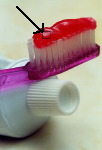There is good news and bad news for those that are resisting digital. The bad news is that digital is the future and there is probably no stopping it. There are two bits of good news. The first is that film will probably be around for good while. Digital cameras are not there yet even though they are getting closer all the time. (However, right now the most impressive output , at least for color, seems to be via film to digital file). The second bit of good news is that digital is not really that difficult once you get past the jargon and acronyms. The key might be to absorb it gradually and to stay away from geeks that think they have impressed you when they make your eyes glaze over.
The Digital Image
A digital image from a digital camera or one
from a film or print scan are basically the same. The image  consists of a large number of tiny squares
called pixels, each of which is a color or, in the case of a black and
white image, a grayscale value. For example, the toothbrush and
toothpaste image to the right contains 15,300 pixels. In the digital
file, each of these pixels has a RGB value. RGB stands for "Red, Green
Blue". Just about any color can be obtained by combining these three
colors. Each of these colors can have a value of between 0 and 255
inclusive. Consequently, there are over 16 million colors (or
combinations) possible (256 x 256 x256).
consists of a large number of tiny squares
called pixels, each of which is a color or, in the case of a black and
white image, a grayscale value. For example, the toothbrush and
toothpaste image to the right contains 15,300 pixels. In the digital
file, each of these pixels has a RGB value. RGB stands for "Red, Green
Blue". Just about any color can be obtained by combining these three
colors. Each of these colors can have a value of between 0 and 255
inclusive. Consequently, there are over 16 million colors (or
combinations) possible (256 x 256 x256).
Remember to think like a photographer and not a painter. You are mixing colors of light not pigments. As a photographer you probably know that if you combine red, green and blue light you get white. In other words, 255 units of red, 255 units of green and 255 of blue or, usually just stated 255, 255, 255 is white. Logically, 0,0,0 is black.

In the image on the left , the area represented by the small black square in the toothbrush/toothpaste image above has been greatly enlarged so that individual pixels can be seen. The RGB values for three of the pixels are shown. The pixel in the lower right corner is almost pure red as indicated by the low green and blue values. If you would like to get a feel for the colors that different values of red, green and blue make, go to this page and play around with different RGB values.
Resolution
Simply put, resolution refers to the ability to distinguish detail. In a digital image, resolution is measured by the number of pixels per inch. The larger the number of pixels the greater the resolution. This should make sense because each pixel must be one color and a detail smaller than one pixel would be lost. Or, at the other extreme, think of a image represented by one pixel (a solid color) and how detail might emerge as the number of pixels is increased.
(If you are in the market for a digital camera or scanner you probably should do an internet search for information to help you understand manufacturer's specifications and claims regarding resolution. A number of sites are available. )
How much resolution should an image have? It depends on the end use. If the image is for use on the internet a high amount of resolution is not necessary since the limiting factor is the resolving power of the screen. Generally speaking, a resolution of 72 to 96 ppi (pixels per inch) is all that is necessary. For printing purposes, top quality images need something in the neighborhood of 300 ppi.
Remember that the ppi figures above refer to the pixels per linear inch. An image one inch square with a resolution of 72 ppi would contain 5,184 pixels (72 x 72) and at 300 ppi it would contain 90,000 pixels. It is easy to see why the digital files are so large. A file capable of producing a good 8 x 10 print would contain 7,200,000 pixels. The file for a color print is much larger than a file for a greyscale print of the same size since the color requires storing RGB values and the greyscale consists of only 256 shades of grey.